Nestled in the heart of Turkey’s Izmir province, Pamukkale, also known as the "Cotton Castle," stands as a captivating natural wonder. This UNESCO World Heritage Site boasts striking white travertine terraces, formed by mineral-rich thermal waters over thousands of years. Visitors come to bask in the therapeutic properties of the warm, calcite-filled pools and explore the ancient ruins of Hierapolis, creating a unique blend of natural beauty and historical significance. But what lies beneath the surface of this mesmerizing destination? Delve deeper to uncover the captivating stories that have made Pamukkale a must-visit attraction for travelers worldwide.
About Your Stay
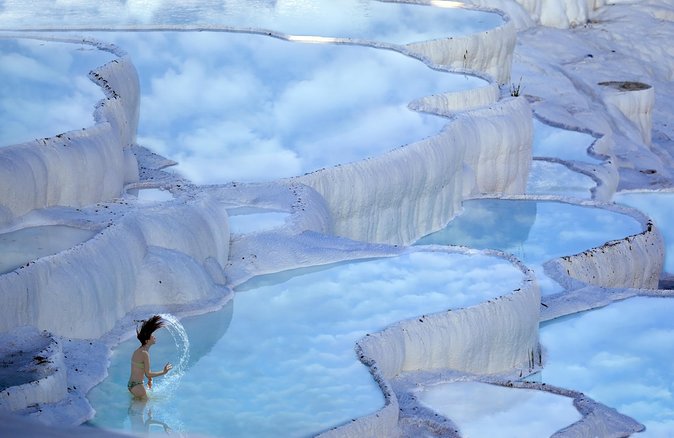
- Pamukkale is a natural wonder in Izmir province, Turkey, known for its striking white travertine terraces and thermal pools formed by mineral-rich waters over centuries.
- The unique terraced landscape and striking colors of the pools, ranging from bright white to deep blue, have made Pamukkale a popular global tourist attraction.
- Pamukkale is home to the ancient Greco-Roman city of Hierapolis, featuring well-preserved ruins, including a theater, Roman baths, and the Martyrium of St. Philip.
- The thermal pools and baths in Pamukkale are believed to have therapeutic properties and are used for relaxation, skin therapy, and treatment of rheumatic conditions.
- Visitors to Pamukkale are advised to wear comfortable, sturdy shoes, use sunscreen and hats, and stay hydrated due to the site’s unique geological features and intense sun exposure.
Overview of Pamukkale
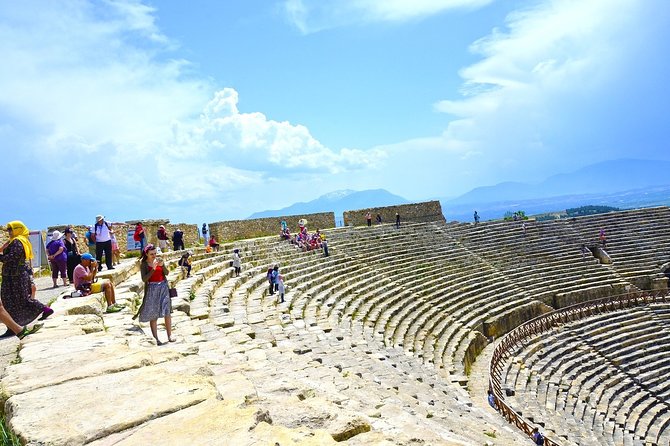
Pamukkale, also known as the "Cotton Castle," is a remarkable natural wonder located in the Izmir province of Turkey.
The site is famous for its terraced thermal pools and white travertine formations, created by the flow of mineral-rich waters over centuries.
Visitors can marvel at the serene, calcified landscape and take a dip in the warm, healing waters.
Pamukkale is one of Turkey’s most popular tourist attractions, drawing visitors from around the world to experience its unique and breathtaking beauty.
With a 4.0-star rating and reasonably priced tours available, Pamukkale is a must-visit destination for those exploring the Izmir region.
You can also read our reviews of more tours and experiences in Izmir.
Geological Wonders
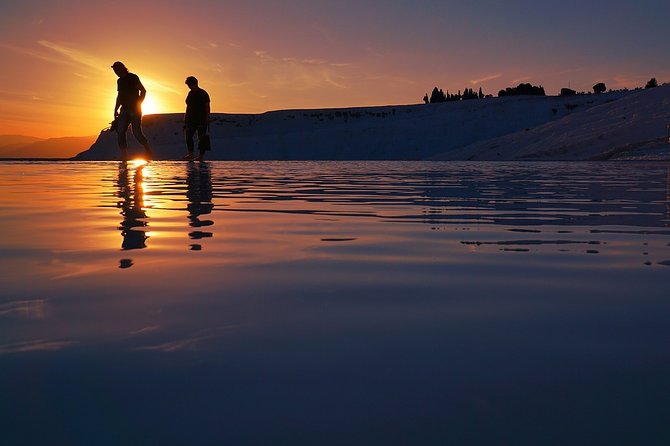
The geological wonders of Pamukkale are the result of a unique natural phenomenon that has unfolded over thousands of years.
Perched atop a hill, the site’s famous white terraces are cascading pools filled with warm, calcite-rich waters that have created an otherworldly landscape.
As the water flows down the terraces, it deposits calcium carbonate, forming the striking white travertine formations.
The vivid colors of the pools, ranging from bright white to deep blue, are a result of the minerals dissolved in the water.
This UNESCO World Heritage Site is a testament to the power of nature and a must-see destination for geology enthusiasts.
History and Culture
Beyond its geological wonders, Pamukkale boasts a rich history and cultural heritage that has captivated visitors for centuries.
This ancient site was once home to the Greco-Roman city of Hierapolis, founded in the 2nd century BC. Hierapolis was renowned for its healing thermal springs, which drew pilgrims from across the Mediterranean.
Today, the ruins of Hierapolis, including a well-preserved theater, Roman baths, and the Martyrium of St. Philip, offer a glimpse into the region’s vibrant past.
Visitors can also explore the Necropolis, an expansive ancient cemetery with sarcophagi, columns, and other artifacts that provide insight into the lives and beliefs of Hierapolis’ inhabitants.
Thermal Pools and Baths
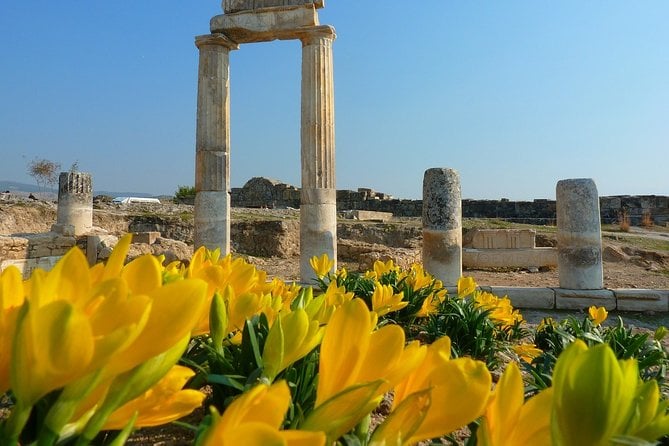
At the heart of Pamukkale’s allure lies its remarkable thermal pools and baths, which have captivated visitors for centuries. These natural wonders, formed by the region’s unique geological features, offer a unique and rejuvenating experience. Visitors can enjoy the warm, mineral-rich waters, which are believed to have therapeutic properties. The pools’ striking white terraces, created by the deposition of calcium carbonate, add to the site’s breathtaking beauty.
| Temperature | Depth | Minerals | Usage |
|---|---|---|---|
| 33-35°C | 1-2 m | Calcium, Magnesium, Sodium | Relaxation, Skin Therapy, Balneotherapy |
| 35-37°C | 1-1.5 m | Calcium, Magnesium, Sulfur | Therapeutic Bathing, Rheumatic Conditions |
| 37-39°C | 1.5-2 m | Calcium, Magnesium, Sodium, Sulfur | Therapeutic Bathing, Balneotherapy |
| 39-41°C | 2-2.5 m | Calcium, Magnesium, Sodium, Sulfur | Therapeutic Bathing, Balneotherapy |
Visiting Pamukkale
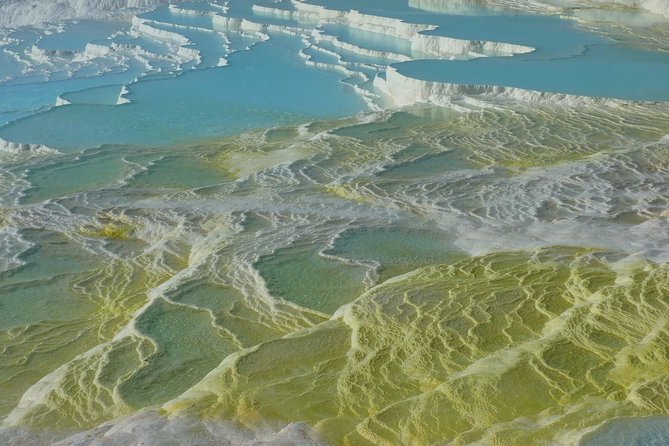
Visitors flock to Pamukkale to witness the captivating travertine terraces and soak in the thermal springs that have drawn people to this remarkable site for centuries.
The UNESCO World Heritage site boasts stunning white limestone landscapes created by the flow of mineral-rich hot springs.
Visitors can explore the ancient ruins of the Greco-Roman city of Hierapolis and hike up the "Cotton Castle" to take in panoramic views.
The accessibility of the site, with options for transport and accommodation, makes Pamukkale a popular day trip from nearby Izmir.
With its unique natural beauty and historical significance, it’s no wonder Pamukkale continues to enchant travelers from around the world.
Tips for Travellers
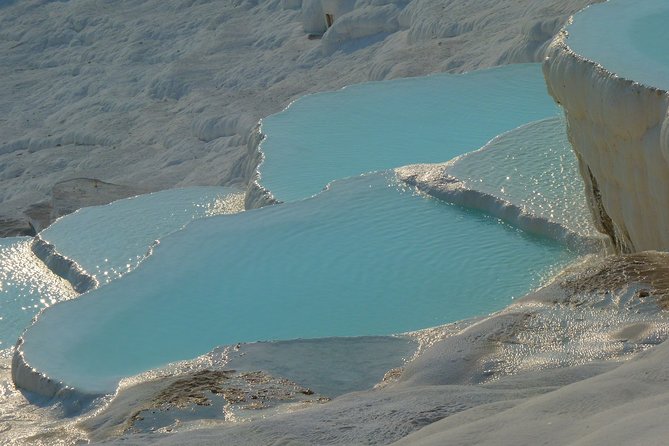
When visiting Pamukkale, travelers should come prepared for the unique terrain and weather conditions.
Comfortable, sturdy shoes are a must, as the travertine terraces can be slippery. Sunscreen and hats are recommended, as the sun can be intense. Bringing a swimsuit is advisable, as visitors can soak their feet in the thermal pools.
Staying hydrated is crucial, so carrying bottled water is recommended. Travelers should also be aware of the site’s accessibility, as it may not be suitable for those with mobility issues.
Following these tips will help ensure a safe and enjoyable experience at the stunning Pamukkale, also known as the "Cotton Castle" of Turkey.
Nearby Attractions
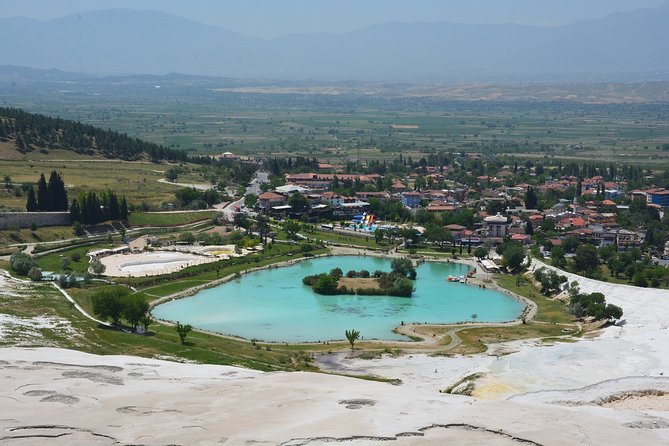
Pamukkale’s proximity to other significant attractions in the region makes it an ideal base for exploring the area.
Just a short drive away, visitors can discover the ancient ruins of Hierapolis, an important Roman spa city.
Travellers can also explore the nearby Kaklik Cave, known for its stunning stalactites and stalagmites.
Other notable attractions include:
- The dramatic Karahayit Red Springs, renowned for their vibrant red-colored waters
- The picturesque Laodikeia Ancient City, which offers a glimpse into the region’s rich history
- The serene Salda Lake, often referred to as the "Turkish Maldives" for its turquoise waters
- The impressive Aphrodisias, an archaeological site dedicated to the goddess of love and beauty.
Questions About Staying Here
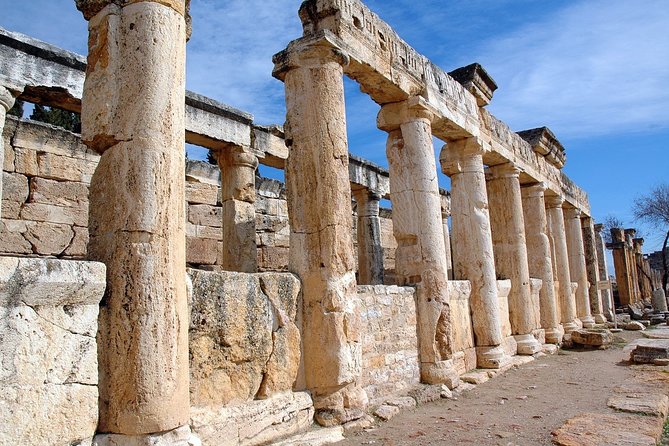
Can I Bring My Own Food and Drinks?
Based on the information provided, visitors are not allowed to bring their own food and drinks on this tour. The tour includes bottled water and soda/pop as part of the inclusions.
Is There a Dress Code for Visiting Pamukkale?
There’s no strict dress code for visiting Pamukkale. Visitors should wear comfortable, weather-appropriate clothing and sturdy, closed-toe shoes to explore the travertine terraces. Light, breathable fabrics are recommended to stay cool in the hot climate.
Are There Any Discounts or Special Offers Available?
There are no explicit discounts or special offers mentioned for this tour, but the lowest price guarantee and reserve now, pay later option may provide some savings. Prices vary based on group size according to the tour details.
Can I Extend My Tour to Visit Nearby Attractions?
You can extend your tour to visit nearby attractions, but this would incur additional costs. The tour operator offers flexibility, and you can inquire about adding extra stops or lengthening the experience to suit your preferences.
What Is the Best Time of Year to Visit Pamukkale?
The best time to visit Pamukkale is during the spring and fall seasons when the weather is mild and comfortable. Visitor crowds are smaller, allowing for a more peaceful experience exploring the stunning white travertine terraces.
Worth The Stay
Pamukkale’s stunning travertine terraces and ancient ruins create an unforgettable experience. Visitors can enjoy the therapeutic thermal pools and explore the well-preserved ruins of Hierapolis, a UNESCO World Heritage Site. With its unique blend of natural and historical wonders, Pamukkale offers travelers a truly captivating destination in Turkey’s Izmir province. It’s a must-visit for anyone seeking to enjoy the country’s natural beauty and rich cultural heritage.
More Tour Reviews in Izmir
Not for you? Here's more things to do in Izmir we have recnetly reviewed
- 2 Best 2 Day Tours In Izmir
- 2 Best Full-Day Tours In Izmir
- 11 Best Lunch Experiences In Izmir
- 2 Days Private Cappadocia Tour From Izmir by Plane
- Private Tour in Izmir
- Private Trip to Ephesus From Izmir Port and Hotels
- 5 Days Biblical Asian Special Izmir Tour
- Izmir Airport ADB Transfers to Kusadasi Hotels
- Magnificent Ephesus Tour From Izmir Cruise Port or Izmir Airport
- Izmir Airport (ADB) to Ayvalık – Arrival Private Transfer
- Departure From Izmir to Izmir Adnan Menderes Airport ADB by Van
- Sardis Tour From Izmir With Private Guide
